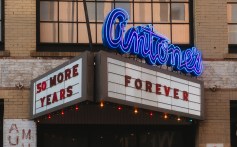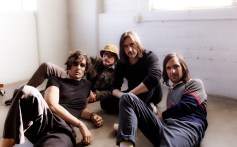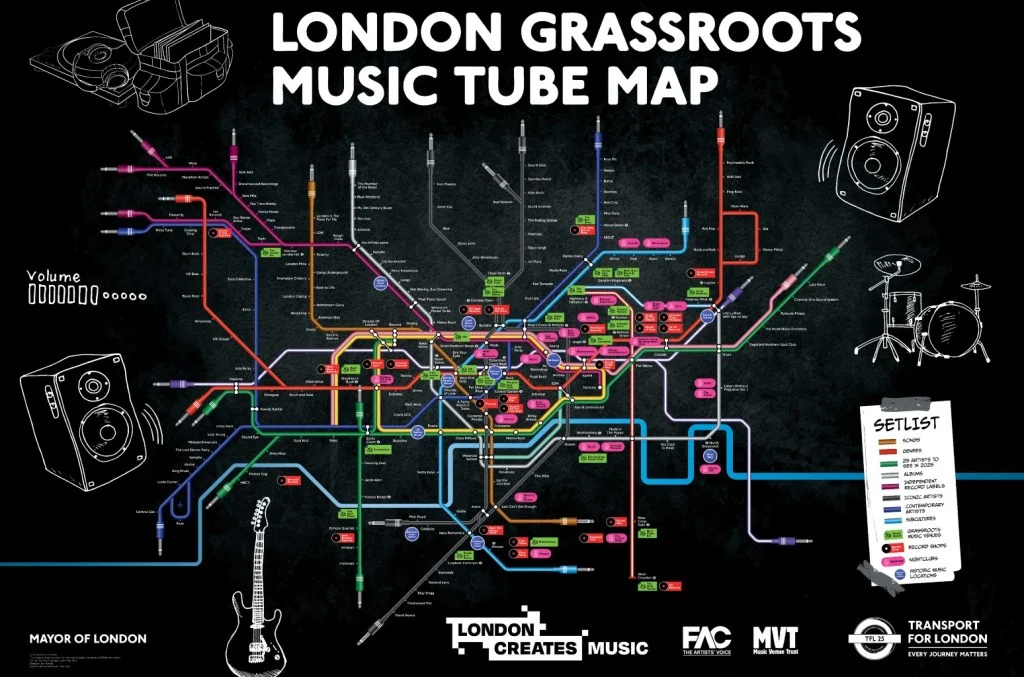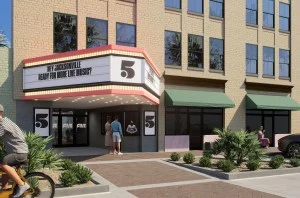venues
Trending on Billboard AEG Presents UK has announced new details about British Airways ARC, an upcoming 3,800-capacity live music venue and event space above the west exhibition hall at the Olympia convention space in London. Set to open in 2026, British Airways ARC is part of a $1.7 billion renovation of Olympia — a 138-year-old […]
Trending on Billboard
Joe Morrison may spend his days working as a personal injury lawyer at law firm Mullen & Mullen, but by night, he’s an avid music fan hoping to protect the live music scene he has supported and nourished for decades.
Together, Morrison, his partner Shane Mullen and Dallas-based production manager Corey Pond have launched the JAMBALOO Music Prize, offering one artist or group a $20,000 check along with professional recording time, promotional support and industry connections in North Texas. The prize represents the latest expansion of the firm’s JAMBALOO Festival, which debuted last year with 25 free shows across different venues in and around Dallas and Fort Worth.
Related
The competition is open to any artist or band with more than 50% of permanent members residing in the Dallas-Fort Worth metro area; artists can participate by submitting an album with seven or more songs via Bandcamp, Spotify, Apple Music or Tidal. Fifteen anonymous judges will evaluate the submissions and select 10 semifinalists who will compete to become one of three finalists. The winner will be chosen through a weighted vote by a panel of experts, as well as a vote by music fans.
“We didn’t want it to be a popularity contest, which is what sometimes these things can turn into, but we did want there to be an element of public voting, because success and popularity do matter,” Pond explains.
Three finalists will perform on June 6 alongside a to-be-determined national headliner, with all tickets free to the public. The June showcase will take place at Longhorn Ballroom, a historic Dallas venue once managed by Jack Ruby, infamous for gunning down Lee Harvey Oswald after Oswald shot and killed U.S. President John F. Kennedy near Dallas’ Dealey Plaza. The Longhorn was reopened by Texas promoter Edwin Cabaniss and Kessler Presents in spring 2023 after a multimillion-dollar renovation that included a new 6,500-capacity outdoor amphitheater.
Related
Besides the $20,000 cash prize, the winner will also win a recording session at Dallas’ Luminous Sound studio with four-time Grammy winner Tre Nagella, as well as featured placement at Josey Records, one of the nation’s largest record stores; a live session recorded at NPR affiliate KXT radio; and an email promotion to 650,000 music fans.
“For a local artist, that [money] could fund an entire new album, that could fund the start of a tour,” says Nagella. “This isn’t like a record deal where they’re beholden to someone — they’re free to use it however they want to use it.”
Mullen & Mullen is also hosting a separate $20,000 venue prize, which was launched after the Fort Worth Music Office reached out about The Cicada, a venue facing closure. The venue prize will become an annual summer competition for independently owned, locally operated music spaces.
“We were looking for a way to kind of give back to the community, but to do it in a fun and unique way,” said Morrison, noting that the firm has invested more than $500,000 in the music initiative so far. “As a personal injury lawyer, who the hell wants to interact with me on social media? It felt better if we could give back in an authentic way where people just see us in a different light.”
Related
The JAMBALOO Music Prize is part of a broader vision for the Mullen & Mullen Music Project, which aims to support the North Texas music scene year-round rather than through a single annual event. Plans include pop-up shows, educational panels and industry mixers modeled after South by Southwest’s programming.
Last year’s inaugural JAMBALOO Festival featured notable performances, including a set by rising indie artist MJ Lenderman. The festival is strategically scheduled in February, traditionally a slow period for venues and artists.
“Let’s try to take a time of the year that’s traditionally bad for the industry and for artists, and turn it on its head a little bit,” Morrison says.
Dallas-based artists can submit their work at JAMBALOO.live.

Trending on Billboard
When Bruce Finkelman opened the Empty Bottle in 1993, he smoked cigarettes, like many of his customers. It was part of his vision for the Chicago rock club: “The small, dark, smoky jazz room or rock ‘n’ roll club. Dingy. That really romantic view of the door opening up and smoke billowing out.” But like every other venue in Chicago and just about everywhere else, Empty Bottle has been smoke-free for decades — and Finkelman, now a non-smoking marathon runner, can’t imagine it any other way. “Even if I smell smoke,” the club’s owner says today, “I’m like, ‘Ugh.’”
The first U.S. indoor smoking ban went into effect almost exactly 35 years ago, in San Luis Obispo, Calif. Since then, just about every municipality followed, from New York City in 2003 to Chicago in 2006 to the entire state of North Dakota in 2012. During that same 35-year period, the concert business has boomed: The top 100 tours grossed $674.5 million in 1990, according to Billboard Boxscore, compared to $10 billion last year, an increase of 1,383%. Promoters, club owners and public-health experts say fans not having to breathe deadly secondhand smoke is almost certainly a reason for that growth.
Related
“It’s part of the equation,” says Dr. Stephen Hansen, who, as the former director of the Sierra Vista Regional Medical Center’s cardiopulmonary department in San Luis Obispo, crusaded for the citywide indoor-smoking ban. “Most places in California, it’s hard to find a smoker these days, and they sure as hell don’t want to be packed in with a crowd where people are smoking.”
Adds Joe Shanahan, owner and founder of Metro, the 43-year-old Chicago rock club: “It really did help business. I believe there is a direct correlation.” He adds that parents were more willing to buy tickets for their 12-to-14-year-old kids to all-ages shows without worrying about the risk of secondhand-smoke exposure.
Given how ecologically serene concerts have been for years — with the exceptions of occasional joints and vapes — the early fights to achieve smoking bans seem like a black and white movie. When Hansen took on Big Tobacco and the entire nightlife scene in San Luis Obispo, a downtown bar owner complained to the Los Angeles Times that he feared his smoking customers would “just find a bar in another city”; a retired truck driver interviewed from a local barstool likened the ban proponents to “Communists,” and added, “That’s the kind of thing they have in Russia.” Just before the city council voted to approve the ban, R.J. Reynolds Tobacco Co. distributed fliers imploring residents to phone council members and oppose an “outrageous attack on your rights!”
Related
The U.S. surgeon general famously laid the groundwork for smoking bans in 1964, when an advisory committee reported a connection between smoking and lung cancer, declaring the habit a “health hazard” in the days of widespread, fashionable, Mad Men-style lighting up. Nine years later, Arizona banned smoking in some areas, and several states followed by enacting limited bans in the ’80s. But Hansen and his San Luis Obispo public-health allies were the first to defeat the formidable opposition to indoor smoking bans. “I did get some calls,” the retired physician recalls. “I got some death threats.”
The country of Ireland studied the example of San Luis Obispo, population 42,000, before enacting its own countrywide ban in 2004 — although Irish public health officials found New York City to be a better case study. “The attitude was, ‘It may be OK to be in California to go outside, but try to tell that to an old man in the west of Ireland with the pouring rain,” says Luke Clancy, a former professor who is director general of the Tobacco Free Research Institute of Ireland.
Back then, after speaking to Irish pub workers — including The Dubliners, a well-known folk band — Clancy and his team realized the smoking ban concept was more popular than it seemed. “I got a lot of feedback from them saying, ‘Thank God for this, my voice is ruined,’” he recalls. “It was not only the audience but the actual artists as well.”
Related
Several studies report that smoking bans have reduced poisonous secondhand smoke, and therefore lung cancer, over the last two or three decades. Jessica Cance, a public-health researcher for independent scientific-research institute RTI International, concluded in a 2015 study that bans have been effective in “decreasing the rates of smoking on college campuses” — and researchers found that alcohol consumption stayed the same at the venues they studied, suggesting young bar patrons didn’t respond to smoking bans by simply leaving to smoke at home. “The data are very clear that smoking bans have been effective for public health,” Cance says. “We can clearly see there is public benefit.”
Numerous club owners and promoters say the bans had an immediate positive impact on their customers and employees, and that fears they had about decreasing attendance never materialized. “If you had 30 or 40 or 50 smokers, the whole room would be an ashtray. My staff were getting sick for no apparent reason,” Metro’s Shanahan says. “When they instituted the smoking ban, and no cigarettes were allowed on a permanent basis, the health of the company turned around in a year. I began to realize business was better.”
The Gothic Theatre near Denver was, in the early ’90s, so smoky that it was difficult to clearly see the stage from the balcony. “It gives me the willies, man,” says Doug Kauffman, who promoted Gothic shows back then. “A lot of business owners complained when it happened: It would hurt their business if you could smoke inside. But it didn’t. What business owner in his right mind wants to kill his customers?”
In the ’90s, smoking at rock clubs gave off an odor so grungy it seemed cool — notably at Washington, D.C.’s 9:30 Club, where one regular described the smell as “Aerosmith and my a——.” But Donna Westmoreland, chief operating officer of I.M.P., the club’s promoter for decades, is a former smoker whose life improved after D.C. officials banned cigarettes at indoor venues in 2006. “I don’t think anybody said, ‘Should we go to a show or not? Well, you can’t smoke now, so we should go’ — but [it’s] probably a contributing factor,” she says. “People aren’t putting out cigarettes on the floor. It might have just felt a little nicer as a result.”
Trending on Billboard
Milwaukee’s newest live entertainment hub, The Argo, will officially open its doors next month inside the historic Fox Bay Theater in Whitefish Bay, anchoring a full-scale renovation of the 1949 Art Deco building and marking the debut of a new mid-size venue for the region’s touring circuit.
The 700-capacity space — which includes a full bar and restaurant, ballroom, and flexible event areas for private rentals, weddings, and community programming — will host its first public concert on Dec. 5 with performances by local artists Chris Haise Band and Zach Pietrini alongside Nashville alt-pop trio VEAUX. The event doubles as a fundraiser benefiting Milwaukee music education programs.
Related
The following night (Dec. 6), Milwaukee rock favorites Goran and Morgan of The Gufs will headline The Argo’s grand-opening celebration, marking the 30th anniversary of their 1995 album Collide.
More than 40 concerts are booked between December and spring 2026, with a mix of touring acts, regional artists and thematic dance parties. Highlights include Grateful Dead tribute act Another One, bluegrass veterans NewFound Road, Minnesota rock band Remo Drive, punk mainstays The Casualties and bluegrass singer Dan Tyminski. A rotating Wednesday swing-jazz residency will feature groups including The Flood, The Sazerac 5, Micro Brew Swing Band and Old Sam & The Teardrops.
The Argo’s ownership group — Andrew J. Coate, Adam Powers and Josh Bryant — completed the venue build-out in under five months after receiving revitalization approval earlier this year. The team has instituted a permanent give-back model, pledging $1 from every ticket sold to support music-industry wellness, with an emphasis on mental health, sustainability and career longevity.
“We’ve lived every angle of this industry — we’ve seen the best of it, we’ve felt the burnout,” Coate says. “The Argo is our way of tipping the scales back toward the good — for our peers, for our city, and for the next generation coming up behind us.”
Talent buying for the venue will be handled exclusively by Knitting Factory Entertainment’s live division, Knitting Factory Presents, led by SVP James Irvine. “This is just the start for The Argo,” Irvine says. “The space is built the right way — production, hospitality, artist amenities — and it has the backbone to become a real destination for touring artists.”
The venue’s bar and kitchen will be helmed by chef Dan Jacobs — a five-time James Beard semifinalist, 2024 nominee and co-owner of Milwaukee restaurants EsterEv and DanDan. The restaurant will soft-open Dec. 5 with a limited menu and will operate independently from ticketed events, allowing locals to dine without attending a show.
Additional partners include exclusive ticketing provider Eventbrite, developer New Land Enterprises and design-build firm Three Sixty Design, whose past work includes Café Centraal and the Milwaukee Athletic Club.
“After months perfecting this venue and the customer experience, we’re finally ready to show our faces to Milwaukee and the world,” Coate adds. “We’re looking to become a must-stop for local artists, prominent touring acts and fans of almost every kind of music.”
The Argo
Three Sixty
The Argo
Three Sixty
A calendar of upcoming dates at Argo is below:
Dec 05 Public Soft Opening ft. VEAUX w/ Zach Pietrini, Chris Haise BandDec 06 Public Grand Opening ft. Goran & Morgan of The Gufs Celebrating 30th Anniversary of CollideDec 10 Swing Jazz Wednesday featuring Old Sam & The TeardropsDec 12 The First Wave (80’s New Wave Tribute)Dec 13 Birth-Tay (Taylor Swift Dancy Party)Dec 17 Swing Jazz Wednesday featuring. The FloodDec 19 Another One (Grateful Dead Tribute)Dec 20 Second Hand News (Fleetwood Mac Tribute)Dec 24 Free Holiday Film ScreeningDec 26 Free Holiday Film ScreeningDec 27 Free Holiday Film ScreeningDec 28 Free Holiday Film ScreeningDec 31 Steve Beguhn Presents “New YearS’ teve”January 2026Jan 07 Swing Jazz Wednesday featuring The Sazerac 5Jan 09 An Evening with Field ReportJan 10 Gabriel HarrisJan 11 School of Rock ShorewoodJan 17 Violet WilderJan 14 Swing Jazz Wednesday featuring Old Sam & The TeardropsJan 23 The Midnight PurchaseJan 24 Pat McCurdyJan 28 Swing Jazz Wednesday featuring Micro Brew Swing BandJan 30 Fool House (90s Dance Party)Jan 31 Hot In Herre (00’s Dance Party)February 2026Feb 04 Swing Jazz Wednesday featuring The Sazerac 5Feb 11 Swing Jazz Wednesday featuring Old Sam & The TeardropsFeb 12 NewFound RoadFeb 15 Whitefish Bay High School Music ClubFeb 18 Swing Jazz Wednesday featuring The FloodFeb 20 Remo DriveFeb 25 Swing Jazz Wednesday featuring Micro Brew Swing BandFeb 28 Jump (Van Halen Tribute)March 2026Mar 04 Swing Jazz Wednesday featuring The Sazerac 5Mar 07 ScythianMar 11 Swing Jazz Wednesday featuring Old Sam & The TeardropsMar 18 Swing Jazz Wednesday featuring Micro Brew Swing BandMar 25 Swing Jazz Wednesday featuring Micro Brew Swing BandMar 28 Bangers Before BedComing SoonApr 03 Not Quite Brothers (Classic Rock Tribute)Apr 10 Smells Like NirvanaMay 16 The CasualtiesMay 29 Dan TyminskiJun 18 Thurston Howell (Yacht Rock Tribute)Aug 8 The Pork Tornadoes
Trending on Billboard
In fall 2026, Live Nation will open the 4,400-capacity indoor music venue The Truth in Nashville.
“Live Nation wanted to be sure that we were adding something that was going to speak to the core of Nashville,” Sally Williams, president of Nashville Music & Business Strategy for Live Nation, tells Billboard.
Related
The Truth will be led by general manager Mickey Davis, and will join AJ Capital Partners’ 18-acre, mixed-use Wedgewood Village development in Nashville’s Wedgewood-Houston.
The venue will highlight talent ranging from global headliners to local Nashville favorites representing an array of musical genres. The Truth, designed by Live Nation’s in-house design and development group Blueprint Studio, will offer a flexible floor plan with three levels in close proximity to the stage, with configurations able to accommodate capacities ranging from 1,800 to 4,400, including standing-room and fully-seated shows.
“This is going to give us the flexibility to host everything from comedians who maybe don’t want a standing room audience to bigger shows where people want to stand,” Williams says. “We will shine the light on Nashville, but we’re going to bring in the biggest stars on the planet, too, from outside of Nashville.”
Williams noted that Live Nation’s Blueprint Studio team spent time in Nashville venues and spoke with Nashville artists, music industry members and historians in creating a venue design intended to honor Nashville’s community.
Related
Throughout, the venue will pay homage to Nashville’s music creators. The Truth takes its name from a quote from late country songwriting legend Harlan Howard, who called country music “three chords and the truth.” Howard, known as a writer on classics including Patsy Cline’s “I Fall to Pieces” and the Buck Owens hit “I’ve Got a Tiger by the Tail,” is also honored through the venue’s whiskey bar, named Harlan’s. Howard’s signature quote is also emblazoned on the front of the venue’s building. Having Howard’s legacy represented within the venue is a full-circle moment for Williams, who recalls that when she first moved to Nashville, one of the first events she attended was the annual Harlan Howard Birthday Bash.
“It represents to me the community that I have found,” Williams says. “It was all of these songwriters singing their songs, and everyone supported. To have his quote, to have people talking about him, means they are talking about songwriters in general, which means they are talking about the foundation of our community. I am beyond proud of that, because I think those are things that we, as a city, have to hold on to.”
The Truth’s two-level, up to 300-person capacity listening lounge, Vinyl Room, will offer a space for gathering and listening to music. Williams tells Billboard that United Record Pressing will be involved in curating vinyls to be displayed in The Truth, as well as providing music for Vinyl Room and the venue’s five backstage dressing rooms. Williams says the Vinyl Room will also be a space that can hold VIP listening sessions and other similar events.
Related
The food and drink menus will highlight local Nashville whiskeys and spirits. Meanwhile, Live Nation teamed with Isle of Printing’s Bryce McCloud to add another visual element to the venue.
“We are going to have an old-school letterpress printing set lists each night for fans to buy and take home,” Williams says. “Set lists are going to be our sort of living art exhibit backstage, too, because every time a show plays here, we will put the set list up and as we move along, it will tell our story visually.”
The backstage will also be outfitted with a family and friends suite overlooking the stage, a large crew lounge, an artist game room/lounge, a multi-use production room and an intimate industry suite.
Live Nation also hopes to hold local music industry events at the venue, such as industry awards and other charitable gatherings.
Related
“People are going to begin to feel like this is their venue, which is what they’re hoping for,” Williams says. “The mission has been to create something other than the sort of box with a stage that you could put anywhere in the world. We wanted to do something completely Nashville-centric.”
The Truth will join other Live Nation venues in Nashville, including Brooklyn Bowl Nashville and Ascend Amphitheater.
Billboard‘s Live Music Summit will be held in Los Angeles on Nov. 3. For tickets and more information, visit https://www.billboardlivemusicsummit.com/2025/home-launch.
LONDON — A number of vital grassroots music venues in the U.K. are set to come under shared ownership in the second phase of a new community-led project.
The Music Venue Properties, the Charitable Community Benefit Society (CBS) created by Music Venue Trust (MVT), seeks to protect grassroots venues by placing them into community ownership and outside of commercial leases with landlords.
Seven grassroots music venue will be included in the next phase of the project: Esquires, Bedford; The Sugarmill, Stoke-on-Trent; The Joiners; Southampton, The Croft, Bristol; Peggy’s Skylight, Nottingham; The Lubber Fiend, Newcastle; The Pipeline, Brighton. The community share offer, which will open on May 15, 2025 and close on July 31, 2025.
The first phase of the Own Our Venues initiative ran in 2023, and raised £2.88m ($3.83m) to secure the ownership of a number of venues across the U.K., including The Bunkhouse in Swansea, Wales, and The Snug in Atherton, England.
Trending on Billboard
An accompanying press release says that the scheme offers a “cultural lease,” that far exceeds the traditional 18 month commercial lease that these venues must operate within. The statement adds, that these cultural leases “ensure fair, sustainable rent, annual contributions toward essential maintenance, and ongoing support in areas such as financial sustainability and operational best practice.”
Ricky Bates, venue operator of The Joiners, Southampton said of the next phase of the program, “We welcome Music Venue Properties’ ownership of our building as the only real solution to securing one of the most important live music venues in the UK. For almost 60 years, The Joiners has been a vital part of the UK touring circuit and a creative cornerstone of Southampton, but today its future is uncertain. Our lease expires this year, our landlord is retiring and, while the venue is rich in history, the building is over 200 years old and in need of care.
“In today’s economy, it simply isn’t viable for us as individuals to purchase the property but, with the support of the Own Our Venues campaign and the wider music community, we can secure The Joiners for the next 60 years and beyond. Be part of this historic moment—get involved and help protect grassroots music for generations to come.”
It’s the latest move by the U.K. music scene in the fightback against closures of independent venues and to support grassroots musicians. On Wednesday (May 14), the team behind The Leadmill in Sheffield, England said that their eviction appeal had been unsuccessful and that they have three months to vacate the premises. The building’s landlord, the Electric Group, runs a number of venues in the U.K. already, including London’s Electric Brixton, Bristol’s SWX and Newcastle’s NX. Oasis, Arctic Monkeys, Pulp and Coldplay are among the legendary artists to play The Leadmill over the years.
LONDON — A new Tube map showcasing the breadth of London’s artists and music venues has been published as part of a campaign championing the capital’s grassroots scene.
The map highlights record shops, nightclubs and historic locations across the city, as well as venues such as XOYO and Electrowerkz to institutions such as the Barbican. London-raised artists including Dua Lipa, Dave and recent Billboard U.K. cover star Loyle Carner also feature.
Each Underground line has been reimagined as a different aspect of the city’s music scene, with the Jubilee line displaying London-made albums, the Metropolitan line showing independent record labels, and the District line listing “25 artists to see in 2025.” The iconic map was designed by Harry Beck and first came into use in 1933.
Trending on Billboard
London mayor Sir Sadiq Khan and Transport for London (TfL) joined forces with media leaders to devise the map as part of the London Creates campaign. Over the next month, it will be displayed at digital exhibition space Outernet London in Tottenham Court Road.
In a statement, Khan said: “London’s grassroots music scene is renowned around the world. From providing opportunities for talented aspiring artists to develop their trade, to giving Londoners a great night out, our venues are an essential part of our life at night and provide a huge boost to our economy.
“However, they have faced huge challenges in recent years, which is why we’re joining with partners across the capital to champion all parts of London’s grassroots music scene. This special edition Tube map is a great way to highlight what a huge impact the scene has on our capital, as we continue to do all we can to support venues and build a more prosperous London for everyone.”
Mark Davyd, founder and CEO of Music Venue Trust, added: “London is one of the world’s great music cities, constantly reinventing itself with new sounds, new genres, and incredible new artists. The network of grassroots music venues in London are an essential part of what makes the capital’s music thrive, delivering an extraordinary range of music, community and life changing experiences at affordable prices.”
According to City Hall, London is home to 179 grassroots music venues, which in the last year have welcomed more than 4.2m audience members, hosted performances by more than 328,000 artists, employed nearly 7,000 people and contributed £313m ($417m) to the economy.
The map was formally published in the Metro newspaper yesterday (May 13). Further information about the campaign can be found at the newspaper’s official website.
Live Nation has agreed to a long-term lease for a 5,000-seat venue in downtown Atlanta that will be part of a development around the Mercedes-Benz Stadium and State Farm Arena.
Centennial Yards is described by CIM, the developer that has partnered with the City of Atlanta, as a “mixed-used community featuring residential units, retail and entertainment establishments, community gathering spaces and more.” The 50-acre site is expected to have a $5 billion price tag. In addition to the music venue, it will include a 14-story hotel, a two-story food and beverage hall and a Cosm entertainment venue. The development already includes a brewery, loft residences and a 500-foot pedestrian bridge.
Live Nation’s involvement with the development was first reported by The Wall Street Journal.
Trending on Billboard
Concert venues are increasingly popular properties in urban developments centered around the venues of professional sports teams. Mercedes-Benz Stadium has been the home of the Atlanta Falcons since 2017. The Atlanta Hawks basketball team plays at State Farm Arena.
“Every owner of a major sports team that wants to have their new building is not just building a building anymore,” Live Nation president/CFO Joe Berchtold said at the J.P. Morgan Global Technology, Media and Communications Conference on Tuesday (May 13). “They’re building an entertainment district around it.”
Centennial Yards is the latest example of concert promoters taking part in developments that aim to revitalize urban areas. Downtown Nashville’s The Pinnacle, a 4,500-capacity music venue operated by AEG Presents, is part of Nashville Yards, owned by real estate developer Southwest Value Partners. Nashville Yards also houses AEG Presents’ regional offices, CAA and, starting in July, Messina Touring Group.
Another massive multi-purpose project getting underway is RFK Stadium in Washington, D.C. The development currently includes a food hall, a skate park and festival grounds that hosts music festivals and other large gatherings. Berchtold said at the conference that he was in D.C. last week but didn’t mention the RFK project.
Leasing a mid-sized venue in Atlanta will add to Live Nation’s portfolio of venues under its Venue Nation business segment. Venue Nation plans to open 20 additional venues globally in 2025, which it believes will add 7 million incremental fans annually. As of the end of 2024, Live Nation leased 222 venues, owned 32 and operated 67. It has the exclusive booking rights to another 69 venues and owns an equity stake in 4.
Facility management company Marathon Live is opening the music venue FIVE, located at Jacksonville, Fla.’s, historic Five Points, on Tuesday night (May 13) with Korean-American singer, musician and internet personality BoyWithUke performing. FIVE is located in a historic 1927 theater that was recently renovated. The work began in August with crews working to preserve the […]
This summer, a number of DJs will be taking the phrase “raise the roof” literally. As announced Monday (May 12), Tao Group Hospitality is partnering with the Edge at Hudson Yards — aka the highest outdoor sky deck in the Western Hemisphere — to install a pop-up nightclub 1,100 feet in the air, setting up […]

 State Champ Radio
State Champ Radio 









